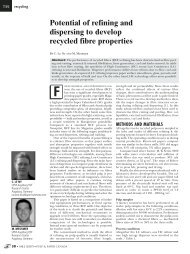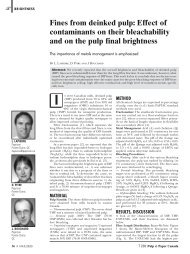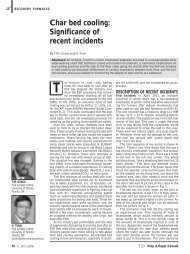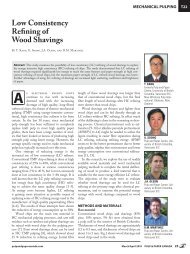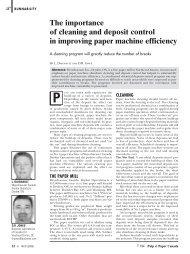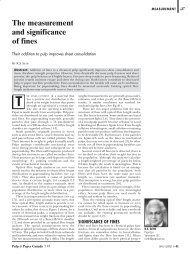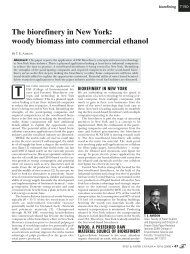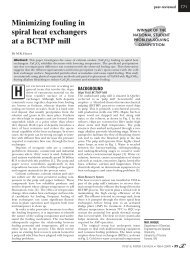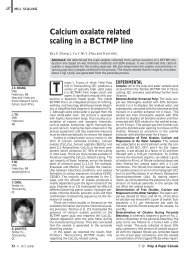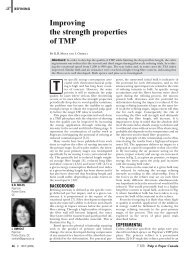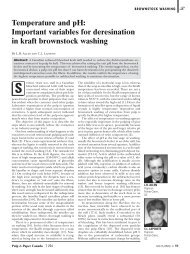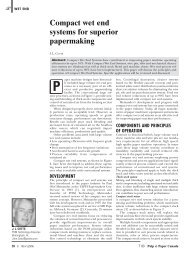Rate determining step and kinetics of oxygen delignification
Rate determining step and kinetics of oxygen delignification
Rate determining step and kinetics of oxygen delignification
You also want an ePaper? Increase the reach of your titles
YUMPU automatically turns print PDFs into web optimized ePapers that Google loves.
T31<strong>oxygen</strong> <strong>delignification</strong>Fig. 1. Flow diagram <strong>of</strong> the continuous stirred tank reactor(CSTR) system.Fig. 2. Delignification rate vs. residual lignin at different O 2pressures.where the constant K c= K HL*·[HL *total]·C.The reaction rate constant, k, is obtainedfrom the slope <strong>of</strong> the <strong>delignification</strong> rateversus L ccurve shown in Figure 2 fora commercial unbleached southern pinekraft pulp (Kappa 26). The linear decreasein <strong>delignification</strong> rate with HexA-freeresidual lignin content, L C, can be intermethod<strong>of</strong> Tenkanen et al. scaled down to200 mg pulp 9 . The residual lignin contentin pulp, L c, was calculated asHexA mg ligninL c= ( Kappa – ––––– ) 31.5 ( –—––––– ) (1)10 g pulpwhere the kappa number is calculated as theinitial pulp kappa number minus the amount<strong>of</strong> lignin dissolved as measured by UV. Thekappa number is corrected for the HexAcontent (in µmol/g pulp). Since 10 µmol/g <strong>of</strong>HexA is equivalent to one kappa unit 10 , theHexA content is divided by 10. The factor1.5 is the st<strong>and</strong>ard conversion <strong>of</strong> kappa to mglignin per gram <strong>of</strong> pulp. Ji has shown that theHexA content <strong>of</strong> pulp does not change during<strong>oxygen</strong> <strong>delignification</strong> except when a severeyield loss occurs so that HexA groups areremoved together with the carbohydrates 11 .The phenolic hydroxyl group content <strong>of</strong> theliquor <strong>and</strong> the pulp was determined from thedifference in UV absorbance <strong>of</strong> neutral <strong>and</strong>alkaline solutions at 300 <strong>and</strong> 350 nm 11-12 . Toavoid lignin precipitation, 100 µl <strong>of</strong> dioxanewas added to the samples.Data analysis procedureDetails about the data analysis procedurecan be found in earlier publications 8, 11 .Development <strong>of</strong> rate expression <strong>and</strong>determination <strong>of</strong> rate constantsIt is well accepted that the first <strong>step</strong> involving<strong>oxygen</strong> <strong>delignification</strong> is dissociation <strong>of</strong>phenolic groups forming an active ligninanion site 3, 5, . L *– . Oxygen <strong>delignification</strong><strong>kinetics</strong> can be interpreted as the result<strong>of</strong> the rate <strong>determining</strong> reaction betweenadsorbed <strong>oxygen</strong> <strong>and</strong> the active ligninanion site, L *– , as:L *– + O 2 $ L *. + O 2.–(2)forming a superoxide anion radical, O .– 2,<strong>and</strong> a lignin radical L *. . Therefore the rateexpression <strong>of</strong> <strong>oxygen</strong> <strong>delignification</strong> maybe written as:dL – ––––– C = k [L* – ]·[O 2] ads(3)dtwhere [L *– ] is the reactive lignin site concentration<strong>and</strong> [O 2] adsis the adsorbed <strong>oxygen</strong>concentration on the reactive ligninsite. The equilibrium constant K HL*<strong>of</strong> theprotonation <strong>of</strong> the lignin active site is:[L *– ][H + ]K HL*= –––––––– (4)[HL * ]When the total number <strong>of</strong> active ligninsites is defined as HL * = total L*– + HL * , it canbe derived that:dL CK HL*[HL * ][OH – ][Ototal 2] – –––– = k ––––––––––––––––––––– ads (5)dt K water+ K HL*[OH – ]where K water= [H + ] 3 [OH - ]. If it is nowassumed that the active sites are uniformlydistributed throughout the residual ligninL c, then [HL * ] = C·L , where C is atotal Cproportionality constant. Thus, equation(5) becomes:dL C[OH – ][O 2] – ––––ads/LC = k = K C= ––––––––––––– (6)dt K water+K HL*[OH – ]preted as a first order reaction in lignin.The wavy character <strong>of</strong> the data is causedby slow small temperature fluctuations(± 1°C) in the CSTR due to imperfectcontrol.Equation 6 predicts that when [OH – ]is very high, the reaction order in [OH – ]approaches zero, <strong>and</strong> that the reactionorder in [OH – ] should approach first orderwhen [OH – ] is close to zero. By taking theinverse <strong>of</strong> equation 6, we obtain1 K HL*K water1– = ––––––– + –––––––– · –––––– (7)k K C[O 2] adsK C[O 2] ads[OH – ]The terms K HL*/K c[O 2] ads<strong>and</strong> K water/K C[O 2] adsare constant when the temperature<strong>and</strong> <strong>oxygen</strong> pressure are kept constant.Thus, by plotting 1/k versus 1/[OH – ] atconstant temperature <strong>and</strong> <strong>oxygen</strong> pressure,but at variable [OH – ], a linear relationshipshould obtained. This is indeed the caseas shown in Figure 3. From the abscissa<strong>and</strong> slope <strong>of</strong> Figure 3 one obtains thatK HL*/K c[O 2] ads= 29.54 <strong>and</strong> K water/K C[O 2] ads= 3.28 or K * = 9.01·K . Since the pK HL water w<strong>of</strong> water, –log(K water), at 90°C is 12.40(Palmer et al. 2004), the pKa <strong>of</strong> the activelignin sites at 90°C is calculated as 11.5.This value is almost two units higher than9.8 measured for Indulin AT at this temperature13 , indicating that the lignin activesite is not a phenolic group.To include the effect <strong>of</strong> <strong>oxygen</strong> pressurein equation 6, a relationship was derivedbetween [O 2] ads<strong>and</strong> P O2based on the followingassumptions:1. Oxygen adsorption follows a Langmuirtype adsorption isotherm,2. The total number <strong>of</strong> adsorption sites isconstant,30 March 2009 Pulp & Paper Canada pulp<strong>and</strong>papercanada.com



